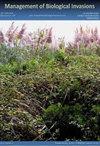Spatial and temporal monitoring of invasive Hydroides dianthus (Verrill, 1873) (Annelida, Serpulidae) in Eel Lake, Argyle, Nova Scotia using a species-specific molecular assay
IF 1.2
4区 环境科学与生态学
Q3 BIODIVERSITY CONSERVATION
引用次数: 1
Abstract
In 2012, an invasion by a serpulid tubeworm, unknown to the Atlantic Canada region, caused heavy biofouling on an oyster lease in Eel Lake, Argyle, Nova Scotia. The species was identified as Hydroides dianthus (Verrill, 1873) , and this morphological identification was confirmed by comparing a newly sequenced COI gene fragment with H. dianthus sequences available in GenBank . Heavy biofouling on the oyster lease resulted in the need to develop mitigation strategies. It was hypothesized that by understanding the spawning behaviour and spatial/temporal patterns of H. dianthus larvae in Eel Lake, biofouling could be mitigated by determining an optimal depth that oyster cages should be maintained at during its active spawning period. To monitor H. dianthus in Eel Lake, species-specific primers associated with the COI gene were developed. Specificity and sensitivity of primers were tested, and the primer set H. dianthus COI4F/R was chosen for monitoring . Water samples were collected from Eel Lake from June to August 2013, and eDNA was extracted. Spatial and temporal monitoring of H. dianthus using eDNA was completed at four sites (three fouled, one non-fouled), and at three depths (0.3 m, 1.5 m, and 3.0 m) in Eel Lake. Water samples tested positive for H. dianthus in most sites and depths on June 20 th , indicating a spawning event had occurred. Subsequently, no significant differences between sites and depths were found and H. dianthus was detected throughout the summer in all locations and depths monitored. The mean % of positive PCR results significantly increased from 18.7 to 65.0% from June to August. Results suggest that H. dianthus spawned frequently during a reproductive season ranging from at least June 20 to August 30 in Eel Lake at temperatures ~ 18–22 °C. The results of this study indicated that an optimal oyster cage depth for biofouling mitigation could not be determined and highlighted the challenges to aquaculture associated with biofouling of H. dianthus .新斯科舍Argyle鳗鱼湖入侵石竹(Verrill, 1873)(环节动物,蛇尾科)的时空监测
2012年,一种加拿大大西洋地区未知的蛇形管虫入侵,在新斯科舍省阿盖尔的鳗鱼湖的牡蛎租赁上造成了严重的生物污染。该物种被鉴定为Hydroides dianthus (Verrill, 1873),并通过将新测序的COI基因片段与GenBank中现有的H. dianthus序列进行比较,证实了这一形态学鉴定。牡蛎租约上严重的生物污染导致需要制定缓解战略。通过对鳗鲡幼虫产卵行为和时空分布规律的了解,可以通过确定鳗鲡产卵活跃期的最佳养殖深度来缓解生物污染。为了监测鳗鲡湖中的石竹,开发了与COI基因相关的种特异性引物。检测引物的特异性和敏感性,选择H. dianthus COI4F/R引物进行监测。2013年6 - 8月采集鳗鱼湖水样,提取eDNA。利用eDNA技术在黄鳝湖4个地点(3个污染点,1个未污染点)和3个深度(0.3 m、1.5 m和3.0 m)完成了石竹的时空监测。6月20日,大部分地点和深度的水样检测结果呈阳性,表明发生了产卵事件。随后,发现地点和深度之间没有显著差异,整个夏季在所有地点和监测深度都检测到石竹。PCR阳性检出率从6 ~ 8月的18.7%显著增加到65.0%。结果表明,黄鳝在6月20日至8月30日的繁殖季节,在温度~ 18 ~ 22℃的条件下,黄鳝产卵频繁。本研究结果表明,无法确定缓解生物污染的最佳牡蛎笼深度,并突出了与石竹生物污染相关的水产养殖挑战。
本文章由计算机程序翻译,如有差异,请以英文原文为准。
求助全文
约1分钟内获得全文
求助全文
来源期刊

Management of Biological Invasions
Agricultural and Biological Sciences-Ecology, Evolution, Behavior and Systematics
CiteScore
3.40
自引率
6.70%
发文量
21
审稿时长
16 weeks
期刊介绍:
Management of Biological Invasions, established in 2010 by Dr. Elias Dana, is an open access, peer-reviewed international journal focusing on applied research in biological invasions in aquatic and terrestrial ecosystems from around the world. This journal is devoted to bridging the gap between scientific research and the use of science in decision-making, regulation and management in the area of invasive species introduction and biodiversity conservation.
Managing biological invasions is a crisis science, with Management of Biological Invasions aiming to provide insights to the issues, to document new forms of detection, measurements and analysis, and to document tangible solutions to this problem.
In addition to original research on applied issues, Management of Biological Invasions publishes technical reports on new management technologies of invasive species and also the proceedings of relevant international meetings. As a platform to encourage informed discussion on matters of national and international importance, we publish viewpoint papers that highlight emerging issues, showcase initiatives, and present opinions of leading researchers.
 求助内容:
求助内容: 应助结果提醒方式:
应助结果提醒方式:


